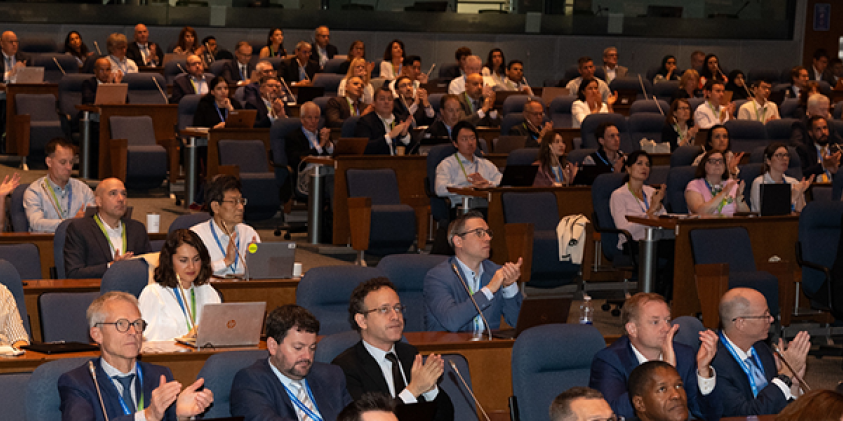Landmark ICAO Symposium highlights the importance of enhanced cooperation on aviation non-CO₂ emissions

Montréal, 23 September 2024 – The International Civil Aviation Organization (ICAO) has initiated the next step in the international community's efforts to reduce air transport's impact on the climate: addressing the non-CO2 emissions from international aviation. While carbon dioxide (CO₂) emissions have long been the focus of international agreements and industry efforts, the sector's non-CO₂ climate impacts have remained uncertain.
ICAO's landmark Symposium on Non-CO₂ Aviation Emissions, held from 16-18 September 2024, drew some 800 attendees both in-person and virtually and focused on topics such as contrail formation, nitrogen oxides and particulate matter, striving to understand and enhance the climate science, potential mitigation measures and policy options.
"We're entering a new era of climate change solutions in aviation, and ICAO is firmly committed to deepening knowledge on this subject, exploring innovative solutions, and forging partnerships" said Salvatore Sciacchitano, ICAO Council President. "This symposium is about more than awareness; it's about charting a course for meaningful action on a problem that requires more scientific understanding."
The event brought together a unique coalition of atmospheric scientists, aerospace engineers, policy makers, and airline operators. Participants represented States, United Nations system organizations, international and regional organizations, industry and related associations, research and development institutions, and academia. This interdisciplinary approach yielded rich discussions on potential mitigation strategies, from altering flight paths to avoid contrail formation to developing cleaner-burning jet fuels.
During the event, ICAO organized an exhibition on the latest initiatives associated with non-CO2 emissions and debuted an educational display installation and a series of videos aimed at addressing common misconceptions about non-CO₂ emissions. To maintain the momentum, ICAO also introduced a new tracking tool for non-CO₂ emissions initiatives.
"This symposium comes at a critical juncture in aviation's climate journey," said Juan Carlos Salazar, ICAO Secretary General. "By addressing non-CO₂ emissions alongside our existing decarbonization efforts, we're taking a more holistic approach to lead aviation to a more sustainable future."
"It is clear that the path forward will require not only technological innovation but further consideration of how we measure and mitigate the full scope of aviation's climate impact" said Secretary General Salazar. "The impressive wealth of information presented during the event from the best scientists, technical experts, industry and academia highlights the importance for ICAO to facilitate continuous cooperation in this area."
Resources for Editors:
About ICAO
A specialized agency of the United Nations, the International Civil Aviation Organization (ICAO) leads the international alignment of technical standards and strategies, facilitating the safe, secure, and sustainable development of its 193 member states' aviation sectors and air services. This year, ICAO is celebrating the 80th anniversary of its establishment by the 1944 Convention on International Civil Aviation.
About ICAO's first Symposium on Non-CO2 Aviation Emissions
- Held in Montréal from 16-18 September 2024.
- Approximately 800 attendees, participating both in-person and virtually.
- Focus areas: Latest scientific knowledge on aviation non- CO₂ effects, work undertaken by ICAO and stakeholders, exploration of future mitigation activities and measures.
- Scientific topics covered: Contrail formation, nitrogen oxides, non-volatile particulate matter, and fuel composition effects.
- New tools: ICAO Tracker tool for non- CO₂ emissions initiatives.
About non- CO₂ aviation emissions
Based on the current scientific understanding, non- CO₂ aviation emissions have a net warming effect on the global climate. Each component of these emissions – water vapour (H2O), nitrogen oxides (NOx), particulate matter (PM), sulphur oxides (SOx), carbon monoxide (CO), and unburned hydrocarbons (UHCs) – can have different impacts on the climate, with scientific uncertainties remaining in fully assessing the radiative forcing.
- Radiative forcing: Radiative forcing assesses the difference between the amount of energy entering the atmosphere and the amount of energy leaving it. If more radiation enters than exits the result is a warming impact known as positive radiative forcing. Conversely when more energy leaves it results in cooling referred to as negative radiative forcing.
- NOx emissions: Nitrogen oxides (NOx) emissions impact the concentrations of other greenhouse gases, such as ozone and methane. Although there is significant uncertainty, nox emissions are likely to contribute to a net warming of climate. Increased ozone at cruise altitudes likely leads to a positive forcing or warming, while other chemical reactions related to increased NOx may cause a negative radiative forcing or cooling. This complexity makes it challenging to evaluate the overall climate impact of NOx.
- Contrails: Contrails form when water vapor from a cruising aircraft condenses and rapidly freezes into ice crystals. At the engine exhaust source of an aircraft, particulate emissions mainly consist of ultrafine soot or black carbon emissions. Such particles are called "non-volatile" (nvPM). While ice crystals can form solely with water droplets, more commonly they form as the result of water vapor on these nvPM particles. The radiative forcing from contrails depends on their persistence and spread. Many uncertainties remain. For example, contrails formed during the night likely have a positive warming radiative forcing while those formed in the day could have a net negative or positive forcing around the world.
These issues are further explained in this ICAO video.
General contact
communications [at] icao.int (communications[at]icao[dot]int)
Media Contact
William Raillant-Clark
Communications Officer
wraillantclark [at] icao.int (wraillantclark[at]icao[dot]int)